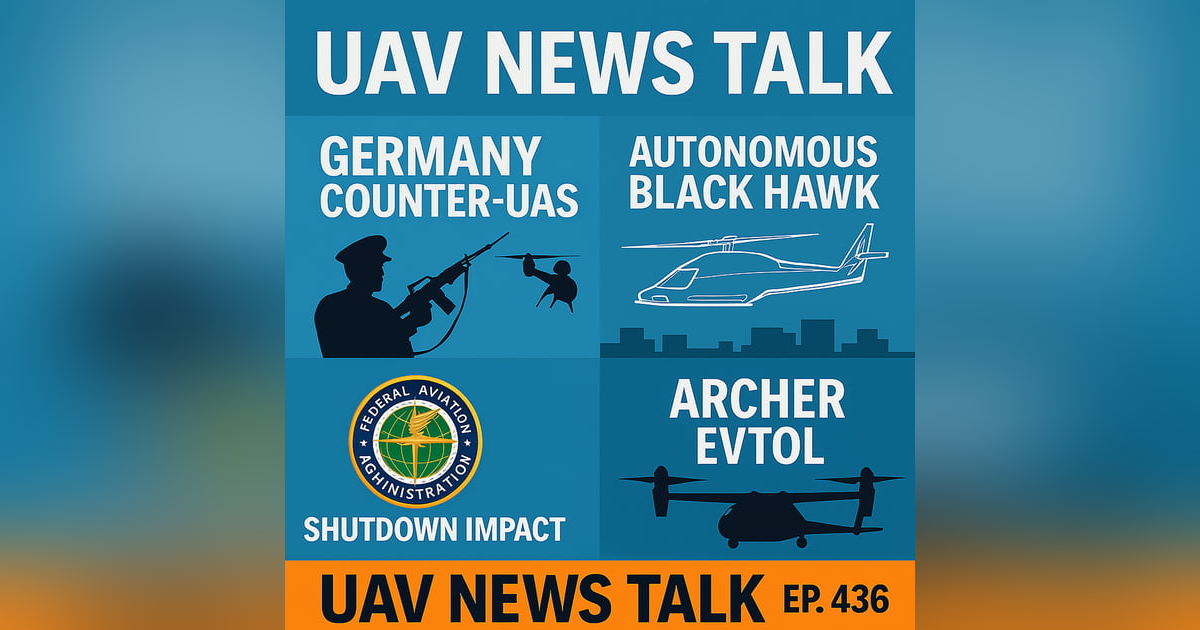Germany’s Drone Crackdown, Sikorsky’s Autonomous Black Hawk, and FAA Shutdown Fallout — UAV News Talk 436

Episode 436 of UAV News Talk dives into global security, emerging automation, and the effects of Washington’s budget stalemate on the future of flight. Hosts Max Trescott and David Vanderhoof examine how nations, defense contractors, and innovators are redefining drone policy and autonomy at the same moment that the FAA’s own progress is slowed by the ongoing government shutdown.
Germany authorizes police to counter rogue drones
The show opens with the news that Germany has approved new counter-UAS authority allowing police to neutralize unmanned aircraft threatening airports and public safety. Max and David debate whether “shoot down” literally means gunfire or refers to electronic jamming and interceptor drones. Max notes that rogue drones have forced multiple Munich Airport closures—172 incidents in 2025 alone—leaving thousands of passengers stranded. David links the policy to Germany’s proximity to the Ukraine conflict, where drone incursions have heightened sensitivity across Europe. The hosts agree that while the measure feels drastic, persistent incursions make formal counter-drone rules inevitable.
Drone-in-a-box systems chase shoplifters
Next, the discussion turns to a futuristic retail-security concept: autonomous drones that pursue shoplifters once they leave a store. The hosts describe how “drone-in-a-box” platforms—similar to systems now deployed for school-campus emergencies—could track suspects until police arrive. Max imagines Apple Stores or high-end jewelers using such tools, while David questions cost and privacy implications. They joke about criminals splitting up so a single drone can follow only one thief. The takeaway: aerial surveillance is extending from military to consumer sectors, and regulation will soon need to catch up.
Sikorsky’s fully autonomous U-Hawk - Video of the Week #1
In one of the episode’s most popular segments, Sikorsky unveils the U-Hawk, an autonomous variant of the UH-60 Black Hawk helicopter. The cockpit has been removed entirely, replaced by cargo-bay clamshell doors for vehicles or supplies. David calls it “a major step beyond optionally piloted,” while Max compares it with Skyryse Aviation’s SkyOS, which retrofits existing aircraft for unmanned flight. Drawing from his own visit to Skyryse’s Southern California facility, Max explains how their flight-automation suite can be adapted to both helicopters and fixed-wing platforms. The hosts discuss potential missions—resupply, firefighting, and hazardous evacuations—and note that Boeing is exploring similar automation for the CH-47 Chinook. The ability to deploy heavy-lift helicopters without pilots, they say, could transform both logistics and combat operations.
Mystery drones over New Jersey explained
A long-running puzzle also gets closure: the mysterious nighttime drone sightings over New Jersey that drew public complaints and congressional attention. New reports reveal that a private defense contractor conducted classified U.S. Army UAS demonstrations, accounting for many of the sightings. The hosts appreciate finally having an answer but point out that such secrecy fuels conspiracy theories and misidentifications. Still, it’s a reminder that rapid testing is happening just beyond public view.
Archer Aviation’s big wins in Korea and L.A.
From defense to commercial innovation, the conversation shifts to Archer Aviation’s new partnerships. In Korea, Archer and Korean Air will run urban-air-mobility (UAM) trials, marking one of Asia’s most advanced eVTOL collaborations. In the U.S., Archer becomes the official air-taxi partner for the Los Angeles Sports & Entertainment Commission, aligning the company with the 2026 World Cup, 2027 Super Bowl LXIX, and 2028 Olympics. Max notes that Los Angeles—with vast geography and hundreds of heliports—offers better infrastructure for eVTOLs than compact, high-rise cities like New York. David recalls the 1984 Olympics’ traffic gridlock and imagines VIPs flying above the congestion in Archer’s Midnight aircraft by the time the next Games arrive.
The foldable Janus 1 “backpack helicopter” - Video of the Week #2
Then comes a lighter story: the Janus 1, a foldable, man-portable tandem-rotor helicopter weighing 70 kilograms (154 lbs). You can watch a video of it flying here. It’s essentially a “flying lawn chair,” says David, but one that could aid isolated troops or appeal to experimental aviators. Max dissects its teetering two-blade rotor—similar to Robinson helicopters—for its simplicity and low cost, while speculating that its symmetrical design inspired the name Janus, after the Roman god who looks both forward and back. The hosts agree that even if it never goes commercial, it showcases the creative energy surging through small-scale VTOL design.
FAA shutdown slows eVTOL certification
Finally, Max explains how the ongoing U.S. government shutdown is affecting aviation oversight. Essential safety functions continue, but rulemaking and certification for new aircraft have slowed. FAA engineers, committees, and inter-agency partners are furloughed, delaying type certificates, airworthiness approvals, and BVLOS waivers. David warns that Europe and Asia could gain a competitive edge if the backlog persists. Even after reopening, he says, catching up could take months. Both hosts remain optimistic that Congress will resolve funding soon, allowing innovation to resume.
Takeaway
Episode 436 captures the global pulse of UAVs and advanced air mobility in late 2025—Europe tightening laws, the U.S. pushing autonomy, Asia expanding UAM, and Washington’s gridlock slowing progress. With equal parts insight and humor, Max Trescott and David Vanderhoof continue to make complex drone news accessible for pilots, engineers, and enthusiasts worldwide.
Check out our other Aviation Podcasts:










